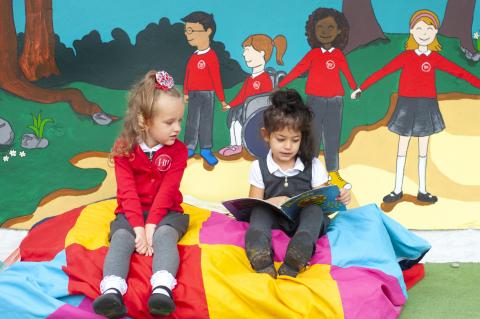This year World Book Day is celebrated on 6 March. It is a highlight in the school calendar, recognising the power of books and inspiring memorable school events from fancy dress days to book fairs. However, there has been some reflection across the sector about how teachers and schools approach World Book Day. As educators, we know that reading is important every day, not just once a year. World Book Day provides an opportunity to come together and share a love of reading, but the question remains as to how we nurture a love of reading every day.
What is reading for pleasure?
The National Literacy Trust defines reading for pleasure as:
‘Reading that we do of our own free will, anticipating the satisfaction that we will get from the act of reading.’
The social, emotional and cognitive benefits of children reading for pleasure are well known. However, in 2021, National Literacy Trust found just 3 in 10 children and young people read something daily in their free time, lower than the level reported during the first national lockdown in spring 2020. Many schools and teachers are working hard to develop good reading habits in their students. However, we know finding time within the curriculum to foster a culture that encourages reading for pleasure can be challenging.
How to encourage reading for pleasure
We recently held a Literacy Network Forum inviting Hackney teachers to come together to discuss how to develop a reading culture in schools. This article outlines some of these approaches with ideas for primary and secondary schools to make memorable experiences that promote a lifelong love of reading. Maybe you’re familiar with these tried and tested strategies, or maybe they’re new to your school, but hopefully they will help to inspire reading for pleasure throughout the year, as well as on World Book Day.
1. Start a book club
A book club can be a great way to encourage reading at home and in school. No time for regular meetings? One-off sessions can also provide meaningful experiences. Why not try a breakfast book club or themed afternoon tea for World Book Day? Here are some ideas to start a book club in your school:
- Pick a theme: Select books based on the time of year e.g. Valentine’s Day, sporting events, Chinese New Year, Halloween, Christmas, etc. Encourage themed fancy dress for some added excitement.
- Let the children decide: Giving young people the opportunity to choose their favourite book for the group to read can boost their confidence and help them get to know one another.
- Get creative: Plan book-related arts and crafts. Draw characters, design book covers, create posters - get children thinking ‘outside the box’ when it comes to books.
- Make it memorable: Build excitement by issuing tickets or invitations in advance and providing drinks, snacks or even a comfy bean-bag or two.
2. Establish reading buddies
The concept of reading buddies is simple: pair older students with younger students to read together. Paired reading can have benefits for both buddies. Older buddies can build confidence and act as a mentor. Younger buddies benefit from one-on-one support and reading alongside a more fluent child. World Book Day could be the perfect opportunity to introduce new buddies. Here are some tips to get you started:
- Assign buddies: An age difference of 3+ years between children can work well so the older child has the skills to assist the younger. Be sure to identify different student personalities and ability levels to create ideal pairs.
- Schedule a time: Select a consistent day each week or month for reading buddies to meet for at least 30 minutes. That way buddies can look forward to the next session.
- Developing a reading area: Create a welcoming space for children to read, choose and talk about books together. Turn a school library, assembly hall or playground (weather permitting!) into a reading haven.
- Define expectations: Clearly explain what will happen in each session and develop a series of steps for buddies to follow, from introductions to taking turns reading. Write the steps on a board or make cue cards to remind pairs of what’s next.
3. Involve all staff
You don't have to be an education expert to know that children are carefully observing those around them. It is important for children to see adults as readers to further their interest and curiosity in reading. Reading is also fundamental to learning in all subjects, so it should be the responsibility of every teacher. Take a whole-school approach involving everyone, from senior management to support staff, to embed reading into the school culture. Why not try:
- Book bulletin boards: Display pictures of staff with their favourite book or book they are currently reading and encourage children to ask questions about them.
- Show and tells: Ask different subject teachers to talk about or read their favourite book to the class for five to ten minutes at the start of a lesson.
- Cross-curricular book walls: Create ‘book wall’ displays for each department or subject with suggested books to encourage cross-curricular reading.
- School book swaps: Ask students and teachers to select one book to lend to another. This will give everyone the opportunity to discover new books and recommend one that excites them. Label each book with names to keep track of who owns which book, and encourage borrowers to talk to owners about their respective books.
4. D.E.A.R
DEAR stands for ‘Drop Everything And Read’. DEAR is a technique used by schools across the country to regularly set aside time in the classroom for both students and teachers to stop what they are doing and pick up a book. DEAR can encourage independent reading and impose it as a routine to help make it a habit. Here are some tips to get started with DEAR in your school:
- Adapt for all ability levels: Older students could read alone and younger students could be read to by their teachers. Pair students who need some extra support with teachers or support staff.
- Involve staff: As already mentioned, children benefit from seeing everyone around them read. Involve all school staff in DEAR for children to see it as a priority.
- Select books in advance: Have students and staff pick a book in advance, be that from home, the classroom or school library. Make sure everyone has their books on the day so they can immediately read when DEAR begins.
- Set a time: Schedule 20-30 minutes at the same time each day or week for DEAR, or why not try a one-off session on World Book Day? Encourage children to read for 15-20 minutes and then record what they read.
- Create a reading log: Have students keep track of their book including the title, author, dates of sessions, number of pages read and short summary in a reading log to bring home. Award children merits if they go above and beyond with their summary.
5. Involve parents and carers
We know supporting and encouraging parents and carers to read with children from an early age can help maintain that habit for as long as possible. In 2018, the Education Endowment Foundation published guidance for schools and teachers to support parental engagement in children’s learning. Using this research, here are some ideas for how to engage parents and carers with reading specifically:
- Critically review how you work with parents: Identify what processes currently exist to engage parents and carers in their child’s reading. If there aren’t any, make a list of possible strategies. Establish what you want to achieve by involving them with a clear list of goals.
- Provide practical strategies to support learning at home: Invite parents for information evenings or celebrations and explain clear ways to help with their child’s reading. Create suggested and recommended term and summer reading lists. The World Book Day £1 book selection provides a list of the best children’s books across fiction, nonfiction and poetry each year accessible for free using a £1 national book token.
- Tailor school communications to encourage positive dialogue about learning: Send texts, emails or termly letters specifically about literacy and reading. Make them personalised for more engagement, for example, celebrating the success of a child or a class. Invite parents and carers to regular ‘reading cafes’ where they join their child in the classroom to read together, and encourage two-way dialogue about how they can be involved at home.
- Offer more sustained and intensive support where needed: Talk openly to parents who are less involved about what they would find helpful to support their child’s reading, communicating carefully to avoid blame or discouragement.
6. Support struggling readers
This article hopefully provides educators with useful ideas to develop a reading culture in schools. However, children who are actively struggling to read will need more than a reading buddy or book club. Teachers and schools need to know when to intervene and provide children with additional support to aid their reading abilities.
Our expert literacy team in Hackney Education specialise in supporting schools, teachers and students to boost literacy and reading attainment across KS1 to KS3. Our acclaimed reading programmes use evidence-based strategies and interactive lessons to enhance students’ reading comprehension, thinking and learning skills, and strengthen their confidence to read independently. Find out more about our reading intervention and teaching programmes below:
Key stage 1 to 2:
- Daily Supported Reading (DSR) is an internationally acclaimed approach to the teaching of early reading in KS1 and to low readers in KS2.
- Destination Reader (DR) is a pedagogical based approach to teaching reading at KS2 used in over 200 schools.
Key stage 3:
- Literacy Intervention Toolkit (LIT) programme is a mindful and metacognitive teaching programme targeting the lowest achieving 20% of pupils in Year 7.
For further information, email literacy@hackney.gov.uk or call 020 8820 7607 to speak to our literacy team.

